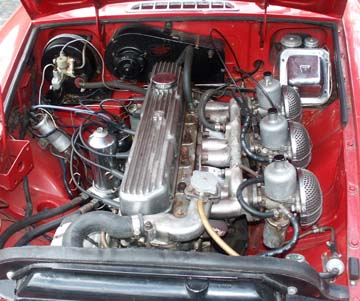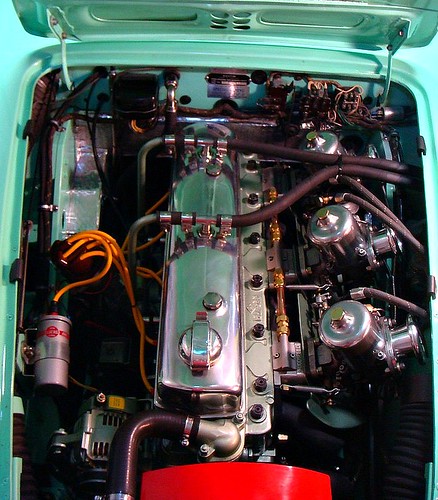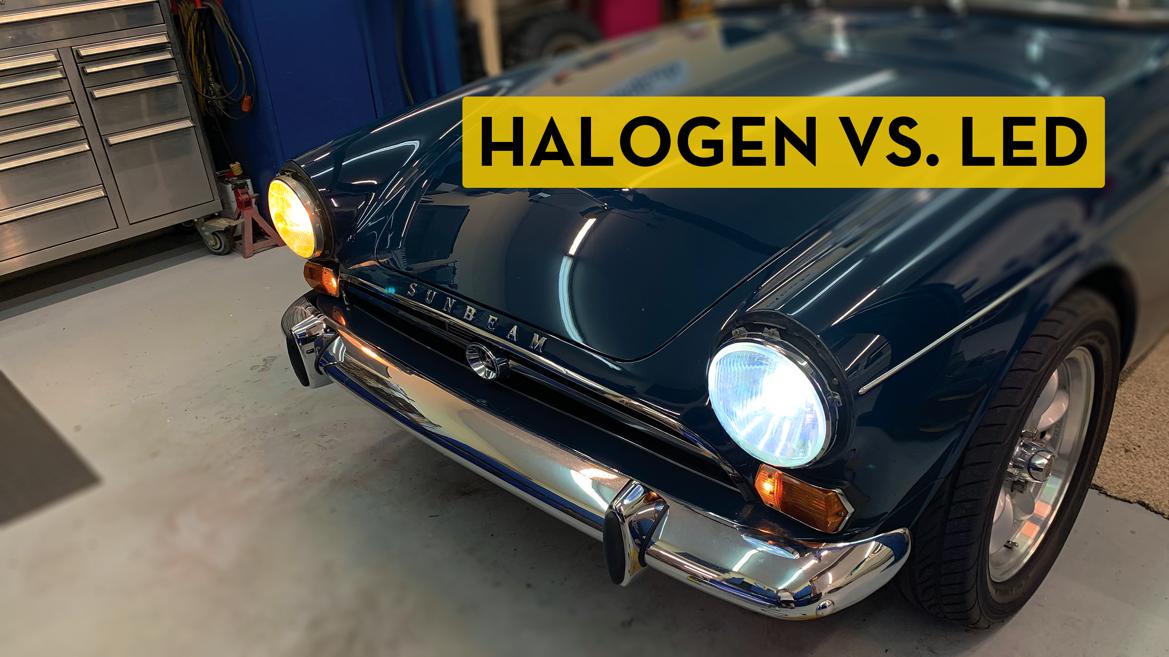wspohn wrote:
"Burlen is reintroducing the dual choke SU carb, the DU.
Prototypes were shown at the Goodwood Festival.
Sizes will be 1-1/2 and 1-3/4"
That link doesn't work - do you have an URL for this? Very interesting. I know some guys that would run these instead of Webers, just to be different!
That was the URL.
I just clicked on it from the posting and it worked, but maybe because the URL was still in my cache.
Here, with quotes:
"https://us-mg6.mail.yahoo.com/neo/b/message?search=1&s=Nz5wn_BkhTz8BSneov4-&encryptQ=1&startMid=0&sort=date&order=down&mid=1_0_AFfuw0MAAAK7Vf%2FHfwDPCPIxtu8&fid=Inbox"
The bottom of the linked page says:
Simply send an email to DU6@sucarb.co.uk expressing your interest and you will receive regular updates specifically about the new Carburetters.
Looks like the URL to something in your Yahoo email account or something you accessed through it. It isn't working for us. Maybe if you post your Yahoo username and password we can view it. JK 
Yeah, I'm on their email list and that arrived.
I searched for, but didn't find a Burlen DU link.
Meanwhile, something like this for a Spitfire ...
(vaguely sexual I think)
http://forums.ctzcc.com/files/su_du_6_dual_throats_1959_60_123.jpg

NOHOME
UberDork
10/16/15 3:22 p.m.
Just finished a E36 M3 show where I installed a professionally rebuilt set of H type carbs on a guys car. They were beautiful to look at and the car ran fine. Of course they pissed fuel out the bottom of the jet assembly. Cause there will ALWAYS be some issue with an SU carb!
Absolutely brilliant design, but they can't quite execute in the real world. There is a reason that the DGV swap has been so successful.

NOHOME wrote:
Just finished a E36 M3 show where I installed a professionally rebuilt set of H type carbs on a guys car. They were beautiful to look at and the car ran fine. Of course they pissed fuel out the bottom of the jet assembly. Cause there will ALWAYS be some issue with an SU carb!
Absolutely brilliant design, but they can't quite execute in the real world. There is a reason that the DGV swap has been so successful.
Gee, I've only been doing SU on LBC for 45 years and NEVER seen an SU that '... pissed fuel out the bottom of the jet assembly...' except when someone screwed the pooch on the build.
Given that a properly adjusted float will maintain the fuel level below the jet opening (assuming someone RTFM and didn't fit a high pressure fuel pump),
and that the fuel tubes are crimped to the jet, the only way they would leak is if someone has seriously damaged something or didn't bother to properly connect the fuel line to the float bowl chamber.
As for DGV swap, hahahahaha, lists are full of unsuspecting newbies that heard 'Weber', got stars in their eyes, and thought they were bolting on some serious kit.
Then #1/#4 runs lean while #2/#3 runs rich, or vice versa, the crankcase pressurizes and blows oil out the dipstick tube, vac advance port doesn't function the same for the dizzy, they spend a bunch of extra time and money buying and trying various jets and tubes trying to get the damned thing to run properly ...
Is that the DGV 'success' you are referring to?

Rupert
Dork
11/2/15 12:15 p.m.
In reply to Basil Exposition: You don't use Webers? Wow are you missing out on a lot of good fun. Carrying a whole box of jets out and finding you never have exactly the right ones for that moment in time, tuning for cool and damp conditions then retuning for hot and dry between heat races, having everyone else in the pits who uses Webers bothering you for spares, or bothering everyone else in the pits using Webers for spares because none in your box of parts works on that specific day, at that specific time of day.
Man why would anyone use SUs or Hitachis? They're not nearly as easy to blame for your terrible laps as Webers are! And you might actually have time to study the course, eat lunch, and plan for your next time on the track. How boring!
But then that's my opinion & I've trod both trails. Others might not agree. And looking at their results, they're right in their case. For me at least the switch/s to Webers hasn't ever been the end-all be-all I expected.
In reply to Basil Exposition:
It's pretty standard that if you have a properly set up set of Webers they will make 15 horsepower more than the 2 inch SU's on a Jaguar. Of course With Webers you needs to have a properly calibrated air density meter that you treat like the crown jewels.. That and a really complete set of jets (60 isn't nearly enough) along with pages, (and pages, and pages) of dyno sheets with tests at various air density figures.

Rupert
Dork
11/4/15 11:58 a.m.
In reply to frenchyd: Yes I had three Webers on mine. Both times, maybe it was three, that I got them perfect it was a perfect ride. However most days I spent more time watching the clouds than watching the track change.
My take is that carbs cannot make power, but they can restrict it. If I build a 140 HP Volvo engine, a pair of 1.75" SUs will support that just fine, and there's no advantage in going to 45DCOEs (which I'd have to choke down pretty far in any case). If I build a 180 HP engine, SUs won't flow well enough to support that, but DCOEs will.
It takes some effort to get the Webers jetted right -- a dyno session is very helpful -- but I've never found that they were at all picky after that. I ran a pair of 48DCOs on a daily driver for years, rain or shine, hot or freezing, and never felt any need to change jets.
In reply to VClassics:
WOW!! I've never heard anyone say that before! After I got my 3 on my Jag and my 3 on my 240Z jetted right they ran great once or twice. The rest of the time they ran OK. Unless of course I spent more time jetting than driving. But when the next weather front came in, they were back to OK. How many jets do you have for your Webers? I often found 100 weren't enough for three carbs at a time.

I've never had a triple setup, which of course would make syncing them that much harder and require half-again as many jets. I really haven't found that they are at all sensitive to temperature or humidity, and they will automatically compensate for air pressure to some extent.
The engine I use for my avatar went into a Carrera Panamerica race car which won the 2-liter class in 2009. That year's running went from sea level in the south of Mexico to over 9000 feet elevation with patches of snow on the ground, and they did just fine with just a selection of three main jets (they did have a wide-band AFR gauge in the cockpit). I'm sure that wasn't optimum at altitude, but they did just fine with it.
On the Volvo engines I deal with, I know that F2 tubes will work with big cams and F15 will work with mild ones. Low-speed jets are either going to be 55F8 or 60F8. Air correctors are going to end up 40 to 50 points higher than the main jets. I've never had to mess with the pump jets or drain. Chokes with depend on the cam and displacement, and those are predictable. That just doesn't leave all that much to experiment with.
I've had SU's on my Volvo's and Webers on my Maserati, (3 2barrels). Both are great and once adjusted the Webers run fine for several years w/o issue, (but no, I don't drive it in the Winter months). The SU's also run fine with a seasonal tune, (then again I am doing valves etc.)
I must note though these are on stock motors and set up as stock as they are meant to be.

wspohn
HalfDork
11/9/15 9:34 a.m.
I have a bunch of Webers in operation but I have a definite soft spot for SUs too.
This is a triple carb system I created for an MGC.


dougie
Reader
11/9/15 11:21 p.m.
I run triple SU HD8's on my '57 100-6 MM Austin Healey vintage racer. I chassis dyno every spring before the race season to fine tune everything, after that I don't touch the carbs for the rest of the year. My SU's have been very reliable for the past 10 years on tracks across the US at different elevations with little to not adjustments.
<img src=" " />
" />

Torqued
New Reader
7/19/21 8:32 p.m.
I'm about 6 years late to the discussion, but for balancing the carbs on my MGA, I had a kit that replaced the damper pistons with a pair of devices that fitted into the oil damper chambers and held two wires bent at right angles to the piston travel. You simply align the tips of the two wires while the engine is shut down, then start the engine and adjust carbs until the tips of the wires re-aligned which would have the venturies of the two carbs open the same amount. Then If they rise evenly/stay aligned, as you open the throttle, the carbs are balanced. This was simple and seemed to work well and didn't depend on me being able to judge from the sound whether the two carbs are drawing the same amount of air. The dashpot pistons will rise faster with the damper pistons removed, but at any given throttle position they should stabilize at the same level. This system also helped me discover a sticky dashpot piston. Is there a problem with this system that I am not aware of?
In reply to Torqued :
Well it's really old system. It's the same one I've used since 1962. It takes a bit of bending wires to do a JaguarXKE with 3 carbs.
I know my new 6 carb set up using MGB carbs on a V12 manifold will really require me to bend a lot of wires.
In reply to dougie :
You are missing the opportunity to put some extra power in your car. If you listen to the weather regularly you might hear them talk about the changing barometer. That just means the air pressure is going up or down depending on the weather.
As the air density goes up your car is getting more air and can use more fuel. That extra fuel means extra power.
Next time on the Dyno check the air density. ( barometric pressure) note the position of the mixture (screw or Nut depending on which carb ).
Now wait a bit until the pressure changes. Readjust the screw or nut until you've got peak power and make note of the change.
The more changes you can see and adjust for the greater potential you have to make peak power during the day of the races. Bring a barometer, check it just before the race and adjust accordingly.
You'll be pleasantly rewarded for your time.

dougie
HalfDork
7/22/21 11:21 p.m.
In reply to frenchyd :
Done & done......
https://youtu.be/8CmGFL54VlA

Is this paragraph correct?
One exception to the "fraction" rule is the more modern HIF44, common to newer Minis. It is also called a "metric" SU because the float is measured in millimeters. (In this example, the horizontal, 44mm internal float measures about 1 3/4 inches across.)
It seems to be saying that the "44" in the "HIF44" carburetor name comes from the size of the "internal float", NOT the size of the "throat":
Would it be more correct for it to be written this way?
One exception to the "fraction" rule is the more modern HIF44, common to newer Minis. It is also called a "metric" SU because the throat is measured in millimeters. (In this example, the horizontal, internal float "HIF44" carburetor's throat measures 44mm or about 1 3/4 inches across, with an accordingly upsized throttle disc, aka "butterfly disc".)
Apologies if someone has already pointed this out - I did a quick search of the comments and didn't see it spotted by anyone else (so it might be me that is wrong!), but this looks to me like a simple typo that was a result of "THRoat" and "FLoat" being such similar words...
;-)

VClassics said:
I've never had a triple setup, which of course would make syncing them that much harder and require half-again as many jets. I really haven't found that they are at all sensitive to temperature or humidity, and they will automatically compensate for air pressure to some extent.
The engine I use for my avatar went into a Carrera Panamerica race car which won the 2-liter class in 2009. That year's running went from sea level in the south of Mexico to over 9000 feet elevation with patches of snow on the ground, and they did just fine with just a selection of three main jets (they did have a wide-band AFR gauge in the cockpit). I'm sure that wasn't optimum at altitude, but they did just fine with it.
On the Volvo engines I deal with, I know that F2 tubes will work with big cams and F15 will work with mild ones. Low-speed jets are either going to be 55F8 or 60F8. Air correctors are going to end up 40 to 50 points higher than the main jets. I've never had to mess with the pump jets or drain. Chokes with depend on the cam and displacement, and those are predictable. That just doesn't leave all that much to experiment with.
On the dyno you need to watch the weather, er air density, like a hawk using the same meter you take to the races with you. You can never, ever, let the meter fly. It needs calibration when you get it because chances are the shipped it on a plane
A cheap way to check its calibration is go out to the airport, call up to the tower and ask them for the barometric pressure. From there it's easy.
Once your meter is set run the engine at different air density's and work For example you listed what works on your Volvo. I had the same set up on my Black Jack Special. First I tested the SU's and then the Webers. Like predicted there was 15 horsepower difference. But I believe most of that was the difference between intake manifolds. The SU's have curving intake manifolds while the Webers are nearly a perfect straight shot. The SU 's are primarily for street use and thus have a longer tract then the Webers the dyno sheets reflected that SU's made slightly more torque and fractionally more bottom end power but once above 3500 the Webers clearly caught up and easing ahead at 6000 rpm ( 500 above factory redline) the Webers made 15 more HP and 7 more ft pds of torque.
Yet if the air density changed enough between pulls the SU's would get most of that back. Unless the correct set up was used.
The SU's needed to be re-needled to go from stock to the higher compression ported head, and billet cams I used. I believe I went from UM needles to UO. And then did a slight polish at the top of the needle
The only time I went to 7000 was that brief time on the dyno. Normally for racing I used 6500 rpm as my absolute race redline. And then on the rare occasion when it made a real difference.
Stone stock bottom end ( except carefully polished and balanced).

































